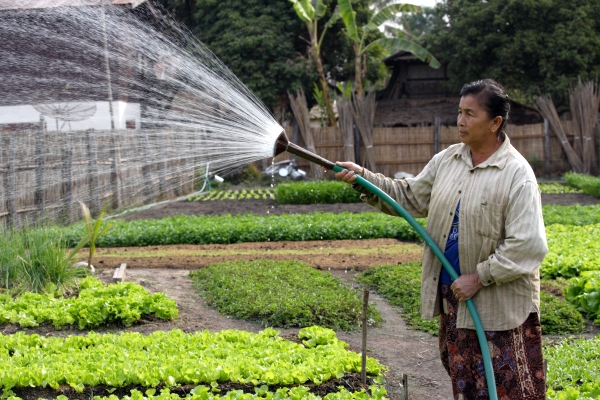What is the link between jobs and water? That may be obvious to those who work in utilities or build water infrastructure, but these sectors represent only a fraction of the jobs that water actually supports.
IWMI’s research work that identified constraints and inequities in the system is now being used as a basis for identifying new approaches.

Take agriculture, which accounts for about 70% of all freshwater withdrawals. It feeds us all of course, but also provides livelihoods for millions of rural families. Some are subsistence farmers many of whom rely on increasingly uncertain rainfall. Others have varying degrees of access to irrigation either from groundwater or surface systems, helping them to create viable income streams and lift their families out of poverty. Reliable access to water is key for that.
The consequences of limited water access for poor farmers are all too obvious in arid regions. Every dry season millions of men abandon their farms and head to the cities to work as casual laborers. Others head overseas to work in the construction industry and service sector. The women left behind struggle to survive on small plots. Some support systems have not moved with the times and inadvertently discriminate against women’s access to resources. Many are unable to afford irrigation pumps or negotiate other forms of water access. So they are stuck producing small quantities of crops that provide little opportunity to improve their overall financial position. At the same time, the migrating men earn so little that remittances make minimal long term difference to household incomes. Add to this the social costs of migration and the strain it can put on poor families whose members live miles apart, and you have a recipe for entrenched poverty and instability.
If more farmers, and especially women farmers, could get access to supplementary irrigation then farming could become a much more viable option. IWMI’s research work that identified constraints and inequities in the system is now being used as a basis for identifying new approaches. Together with our partners in Bihar State and the Nepal Terai, IWMI is working with groups of poor tenant farmers to form cooperatives. By banding together they are more able to afford simple irrigation technologies. The new generation of portable solar pumps are ideal for this. Although small, they have the advantage that if a landlord decides to reclaim the land, the pump can be easily moved to another site. By making farming more profitable and flexible, it is hoped that tenants will ultimately able to negotiate better deals with landowners, replacing exploitative sharecropping arrangements with more straightforward commercial agreements.
So water access can create livelihoods, but if resources are limited, how can policy makers and communities decide how to allocate water that also increases employment? A “more jobs per drop” approach has been studied by IWMI in South Africa. Here water supplies are severely constrained – even more so in the current drought. Unemployment is high, so working out how best to use water for livelihoods becomes critical. With competing demands from industry, commercial farming and smallholders, water allocation is not just challenging, but increasingly politically charged.
The research revealed that the most efficient use of water in terms of employment is in urban areas supporting light industry and services. This, however, ignores the significant economic multiplier effects of water use in the primary industries like agriculture and mining. The study also underlined the complexity of relationship between water and employment and the need to take into account other factors like environmental degradation when assessing how best to allocate resources.
Global trends are likely to make reconcniling water use and job creation even more challenging in the coming decades. Demands on water supplies are increasing. Technological change is accelerating and can open up new markets for farmers as they get increasingly connected. In developing economies farming will become increasingly automated, changing the nature of employment and placing conventional jobs at risk. . Male migration and an ageing farming population is changing rural landscapes. At the same time a demographic bulge of young people is entering the global job market and in Africa this will continue for decades. More extremes of flood and drought further complicate the picture. How we respond to these rapidly changing situations and the consequence for water will define development for years to come.
The UN’s sustainable development goals (SDGs) provide the framework for addressing these challenges and include a goal specifically for “decent work”. Wise use of water can help deliver on this, but water is also critical to achieving almost all the other SDGs. Against this backdrop of increasing pressures, water management will become an even more skillful balancing act requiring great commitment and involving multiple trade-offs. Business as usual is no longer an option and a context specific, evidence-based understanding of the linkages between local economies, social systems and natural resources will be necessary to craft the solutions needed across the broad spectrum of SDGs, including jobs.

